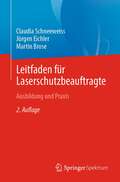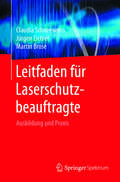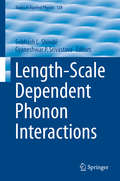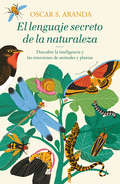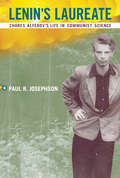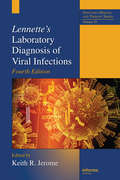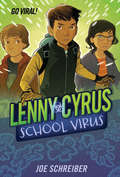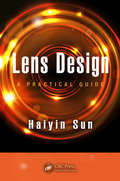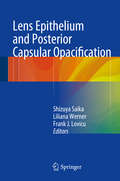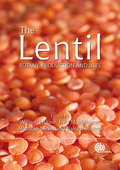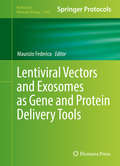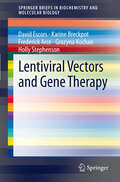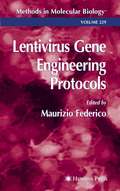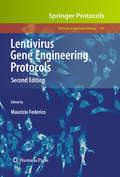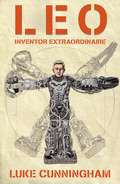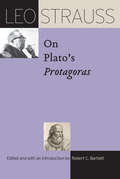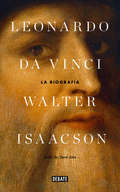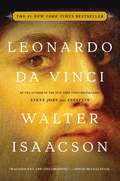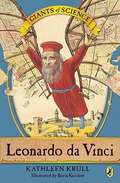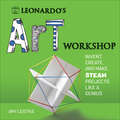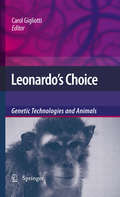- Table View
- List View
Leitfaden für Laserschutzbeauftragte: Ausbildung und Praxis
by Jürgen Eichler Claudia Schneeweiss Martin BroseDas vorliegende Buch dient künftigen und bereits praktizierenden Laserschutzbeauftragten als kompaktes Nachschlagewerk und bietet Hilfestellung bei praktischen sowie theoretischen Fragen im Umgang mit Lasern in allen Anwendungsbereichen. Durch konkrete Übungsaufgaben und Testfragen mit Lösungen in jedem Kapitel eignet es sich als begleitendes Lehrbuch für die Aus- und Weiterbildung von Laserschutzbeauftragten bzw. als Ergänzung zu den entsprechenden Kursen.Das Werk basiert dabei auf den Anforderungen der Arbeitsschutzverordnung OStrV und der Technischen Regeln Optische Strahlung (TROS-Laserstrahlung), die diese konkretisieren. Gleichzeitig bildet es die Inhalte der Kurse zur Ausbildung von Laserschutzbeauftragten an der Akademie für Lasersicherheit Berlin und der Berufsgenossenschaft BG ETEM ab.
Leitfaden für Laserschutzbeauftragte: Ausbildung und Praxis
by Claudia Schneeweiss Jürgen Eichler Martin BroseDas vorliegende Buch dient künftigen und bereits praktizierenden Laserschutzbeauftragten als kompaktes Nachschlagewerk und bietet Hilfestellung bei praktischen sowie theoretischen Fragen im Umgang mit Lasern in allen Anwendungsbereichen. Durch konkrete Übungsaufgaben und Testfragen mit Lösungen in jedem Kapitel eignet es sich als begleitendes Lehrbuch für die Aus- und Weiterbildung von Laserschutzbeauftragten bzw. als Ergänzung zu den entsprechenden Kursen.Das Werk basiert dabei auf den Anforderungen der Arbeitsschutzverordnung OStrV und deren, sie konkretisierenden, Technischen Regeln Optische Strahlung (TROS-Laserstrahlung). Gleichzeitig bildet es die Inhalte der Kurse zur Ausbildung von Laserschutzbeauftragten an der Akademie für Lasersicherheit Berlin und der Berufsgenossenschaft BG ETEM ab.
Length-Scale Dependent Phonon Interactions
by Subhash L. Shindé Gyaneshwar P. SrivastavaThis book presents a comprehensive description of phonons and their interactions in systems with different dimensions and length scales. Internationally-recognized leaders describe theories and measurements of phonon interactions in relation to the design of materials with exotic properties such as metamaterials, nano-mechanical systems, next-generation electronic, photonic, and acoustic devices, energy harvesting, optical information storage, and applications of phonon lasers in a variety of fields. The emergence of techniques for control of semiconductor properties and geometry has enabled engineers to design structures in which functionality is derived from controlling electron behavior. As manufacturing techniques have greatly expanded the list of available materials and the range of attainable length scales, similar opportunities now exist for designing devices whose functionality is derived from controlling phonon behavior. However, progress in this area is hampered by gaps in our knowledge of phonon transport across and along arbitrary interfaces, the scattering of phonons with crystal defects, interface roughness and mass-mixing, delocalized electrons/collective electronic excitations, and solid acoustic vibrations when these occur in structures with small physical dimensions. This book provides a comprehensive description of phonons and their interactions in systems with different dimensions and length scales. Theories and measurements of phonon interactions are described in relation to the design of materials with exotic properties such as metamaterials, nano-mechanical systems, next-generation electronic, photonic, and acoustic devices, energy harvesting, optical information storage, and applications of phonon lasers in a variety of fields.
El lenguaje secreto de la naturaleza: Descubre la inteligencia y las emociones de animales y plantas
by Oscar S. ArandaUn canto de amor a los animales. Un viaje a lo más profundo de la naturaleza. Todos nos hemos admirado alguna vez ante la grandiosidad y la belleza de la naturaleza. Este libro es un viaje que nos llevará por maravillosos lugares alrededor del mundo para conocer de cerca a seres que, al igual que nosotros, tienen familia, emociones, enfrentan desafíos, toman decisiones y crean alianzas. He dedicado toda mi vida y mi carrera de biólogo al estudio y a la protección de los animales. Espero contagiarte mi admiración por la naturaleza, mi amor por los árboles y mi devoción hacia otros animales que han marcado mi afortunada vida repleta de circunstancias excepcionales, grandes aventuras y encuentros fantásticos con seres sorprendentes. Acompáñame y descubre mi forma de ver el mundo, un lugar donde, sin importar que tengamos el aspecto de un helecho, el carácter de una mosca, la valentía de una hormiga o el corazón de una gaviota, todos somos iguales.
El lenguaje secreto de la naturaleza: Descubre la inteligencia y las emociones de animales y plantas
by Oscar S. ArandaUn canto de amor a los animales. Un viaje a lo más profundo de la naturaleza. Todos nos hemos admirado alguna vez ante la grandiosidad y la belleza de la naturaleza. Este libro es un viaje que nos llevará por maravillosos lugares alrededor del mundo para conocer de cerca a seres que, al igual que nosotros, tienen familia, emociones, enfrentan desafíos, toman decisiones y crean alianzas. He dedicado toda mi vida y mi carrera de biólogo al estudio y a la protección de los animales. Espero contagiarte mi admiración por la naturaleza, mi amor por los árboles y mi devoción hacia otros animales que han marcado mi afortunada vida repleta de circunstancias excepcionales, grandes aventuras y encuentros fantásticos con seres sorprendentes. Acompáñame y descubre mi forma de ver el mundo, un lugar donde, sin importar que tengamos el aspecto de un helecho, el carácter de una mosca, la valentía de una hormiga o el corazón de una gaviota, todos somos iguales. «El lenguaje secreto de la naturaleza nos invita a contemplar nuestro alrededor con una mirada nueva, con una curiosidad con la que, tal vez, no lo habíamos hecho antes.»Blog Anika entre libros.
Lenin's Laureate: Zhores Alferov's Life in Communist Science (Transformations: Studies in the History of Science and Technology)
by Paul R. JosephsonThe life and work of a leading Soviet physicist and an exploration of the strengths and weaknesses of Soviet science from Stalin through Gorbachev.In 2000, Russian scientist Zhores Alferov shared the Nobel Prize for Physics for his discovery of the heterojunction, a semiconductor device the practical applications of which include LEDs, rapid transistors, and the microchip. The Prize was the culmination of a career in Soviet science that spanned the eras of Stalin, Khrushchev, and Gorbachev—and continues today in the postcommunist Russia of Putin and Medvedev. In Lenin's Laureate, historian Paul Josephson tells the story of Alferov's life and work and examines the bureaucratic, economic, and ideological obstacles to doing state-sponsored scientific research in the Soviet Union. Lenin and the Bolsheviks built strong institutions for scientific research, rectifying years of neglect under the Czars. Later generations of scientists, including Alferov and his colleagues, reaped the benefits, achieving important breakthroughs: the first nuclear reactor for civilian energy, an early fusion device, and, of course, the Sputnik satellite. Josephson's account of Alferov's career reveals the strengths and weaknesses of Soviet science—a schizophrenic environment of cutting-edge research and political interference. Alferov, born into a family of Communist loyalists, joined the party in 1967. He supported Gorbachev's reforms in the 1980s, but later became frustrated by the recession-plagued postcommunist state's failure to fund scientific research adequately. An elected member of the Russian parliament since 1995, he uses his prestige as a Nobel laureate to protect Russian science from further cutbacks.Drawing on extensive archival research and the author's own discussions with Alferov, Lenin's Laureate offers a unique account of Soviet science, presented against the backdrop of the USSR's turbulent history from the revolution through perestroika.
Lennette's Laboratory Diagnosis of Viral Infections (Infectious Disease and Therapy)
by Keith R. JeromeWritten from the perspective of the diagnostician, this bestselling book is the definitive text on the laboratory diagnosis of human viral diseases. It contains a wealth of illustrations, tables, and algorithms to enhance your understanding of this ever-evolving field. The book is a ready reference for virologists, microbiologists, epidemiologists, laboratorians, and infections disease specialists, and students.
Lenny Cyrus, School Virus
by Joe Schreiber Matt SmithIt seemed so logical at first. Fourteen-year-old Lenny Cyrus had loved Zooey Andrews since third grade. All the boy genius needed to do to win her heart, surely, was shrink down to the size of an amoeba, ooze into a gelatin capsule, and have his friend Harlan slip it (him!) into Zooey's Diet Coke. Told in three voices, this fantastical middle grade novel takes Lenny deep into Zooey's loud, splashing innards, where a talking astrovirus named Astro has a bad attitude about white blood cells ("self-righteous pus-bags") and aromatic hormones disco dance. The question is, will Lenny and Zooey survive his crazy experiment in nanotechnology? The worst part comes when Lenny inadvertently triggers an infection in Zooey's brain, and her whole body goes into lockdown. Can Lenny rescue Zooey before his time is up? Lenny Cyrus is determined to find his way into Zooey's heart. Literally.
Lens Design: A Practical Guide (Optical Sciences and Applications of Light)
by Haiyin SunA Practical Guide to Lens Design focuses on the very detailed practical process of lens design. Every step from setup specifications to finalizing the design for production is discussed in a straight forward, tangible way. Design examples of several widely used modern lenses are provided. Optics basics are introduced and basic functions of Zemax are described. Zemax will be used throughout the book.
Lens Epithelium and Posterior Capsular Opacification
by Shizuya Saika Liliana Werner Frank J. LovicuThis book is the first to summarize the current knowledge of the cell biology of lens epithelial cells in relation to and in the development of posterior capsular opacification (PCO). PCO remains the most common long-term complication of modern cataract surgery, occurring months or years after cataract surgery, unlike most other complications that tend to arise during or soon after the procedure. Opacification of the posterior capsule appears to be linked to lens epithelial cells that are left behind in the eye during cataract removal. These cells proliferate, migrate across the posterior lens capsule, and undergo changes that result in fibrous or pearl-type opacities in the capsule. The first section of the text explains the molecular mechanism and biology of lens epithelial cells that lead to the incidence of PCO. In the second part, in addition to a description of the mechanism and pathological condition of PCO, surgical methods and devices for preventing PCO are discussed in detail. Lens Epithelium and Capsular Opacification will benefit not only young clinical residents and junior researchers, but also established faculty in the clinical or basic academic field.
The Lentil: Botany, Production and Uses
by William Erskine Fred J. Muehlbauer Ashutosh Sarker Balram SharmaThe lentil has an ancient origin but is now confronted with issues of food security, poverty, water scarcity and the need to find sustainable agricultural systems in a changing climate. A crop primarily grown in the developing world, it is ideally suited to address these issues through its ability to use water efficiently and grow in marginal environments as well as being high in protein and easily digestable. In the last three decades, the global production of lentils has almost tripled due to larger harvest areas but also more importantly to progress in research and productivity. Chapters outline improvements in production, such as water and soil nutrient management, agronomy, mechanization and weed management. Developments in genetics and breeding are discussed alongside improved knowledge of the lentils origin, domestication, morphology and adaptation. The implementation and impact of this new research at the farm level is also addressed as well as the crops post-harvest processing and nutritional value.
Lentil
by Fred Muehlbauer Balram Sharma Ashutosh Sarker William ErskineIn the last three decades, the global production of lentils has almost tripled due to larger harvest areas but also more importantly from progress in research and productivity. Chapters outline improvements in production, such as water and soil nutrient management, agronomy, mechanization and weed management. Developments in genetics and breeding are discussed alongside improved knowledge of the lentil's origin, domestication, morphology and adaptation. The implementation and impact of this new research at the farm level is also addressed as well as the crop's post-harvest processing and nutritional value.
Lentiviral Vectors and Exosomes as Gene and Protein Delivery Tools
by Maurizio FedericoThis volume provides current methods and protocols for gene and protein delivery based on both lentivirus-generated and spontaneously released nanovesicles. "Lentiviral Vectors and Exosomes as Gene and Protein Delivery Tools "guides readers through methods on macromolecule delivery and chapters describe the LV-based protocols of gene engineering. Written in the highly successful "Methods in Molecular Biology "series format, chapters include introductions to their respective topics, lists of the necessary materials and reagents, step-by-step, readily reproducible laboratory protocols, and tips on troubleshooting and avoiding known pitfalls. Authoritative and cutting-edge, "Lentiviral Vectors and Exosomes as Gene and Protein Delivery Tools" aims to ensure successful results in the further study of this vital field.
Lentiviral Vectors and Gene Therapy
by Frederick Arce David Escors Grazyna Kochan Karine Breckpot Holly StephensonGene therapy was conceived during the early and mid part of the 20th century. At first, it was considered a revolutionary biomedical procedure, which could potentially cure any disease for which the molecular bases were understood. Since then, gene therapy has gone through many stages and has evolved from a nearly unrealistic perspective to a real life application. Clinical efficacy in humans was demonstrated at the beginning of this century after its successful application in small-scale clinical trials to cure severe immunodeficiency in children. However, their successes were overshadowed some time later by the occurrence of vector-related leukaemia in a number of treated children. It is in this context that lentiviral vectors have appeared, with improved efficiency and, possibly, increased biosafety. Very recently, the first clinical trials with lentivectors have been carried out with some success. This Brief firstly defines gene therapy, and places lentivectors within this fascinating therapeutic strategy. Then follows a comprehensive description of the development of retroviral and lentiviral vectors and how to specifically target distinct cell types and tissues. The authors also discuss the application of lentivector gene therapy for the treatment of cancer and autoimmune diseases, ending with the application of lentivectors in human gene therapy clinical trials.
Lentivirus Gene Engineering Protocols
by Maurizio FedericoLentivirus vector-based technologies, through in vitro and in vivo gene transfer in eukaryotic animal cells, currently offer the most promising opportunities for curing genetic disorders, as well as cancer and infectious diseases. In Lentivirus Gene Engineering Protocols, Maurizio Federico has assembled a panel of outstanding experimenters to detail all the theoretical and practical aspects of lentivirus vector-based gene transfer. The authors demonstrate lentivirus vector production with detailed methods for recovering appropriate producer cells, for producing and titrating lentivirus-containing supernatants, and for detecting transduced cells. The applications of lentivirus vector engineering to different cell types include coverage of lymphocytes, dendritic cells, hematopoietic stem and progenitor cells, mesenchymal stem cells, hippocampal neurons, cardiomyocytes, as well as airway epithelia, corneal cells, and retinal pigment. The use of non-HIV-1-based lentivirus vectors is shown to be advantageous, particularly those obtained from the genomes of HIV-2, SIV, or FIV. Also advanced are applications in which genetic material is directly inoculated with lentivirus vectors in such experimental animal models as mouse, rat, and rabbit. <P><P> Comprehensive and informative, Lentivirus Gene Engineering Protocols presents a broad spectrum of the latest methods of lentivirus vector technology, offering hematologists, neurologists, geneticists, and virologists the most promising and up-to-date tools available for gene therapy in such still fatal diseases as cancer, cystic fibrosis, and AIDS.ctical aspects of lentivirus vector-based gene transfer. The authors demonstrate lentivirus vector production with methods for recovering appropriate producer cells, for producing and titrating lentivirus-containing supernatants, and for detecting transduced cells. The applications of lentivirus vector engineering to different cell types include coverage of lymphocytes, dendritic cells, hematopoietic stem and progenitor cells, mesenchymal stem cells, hippocampal neurons, cardiomyocytes, as well as airway epithelia, corneal cells, and retinal pigment. Also advanced are applications in which genetic material is directly inoculated with lentivirus vectors in such experimental animal models as mouse, rat, and rabbit.
Lentivirus Gene Engineering Protocols, 2nd Edition
by Maurizio FedericoSince the publication of the first edition, lentivirus vector-based technologies, through in vitro and in vivo gene transfer in eukaryotic animal cells, continue to offer the most promising opportunities for curing genetic disorders, as well as cancer and infectious diseases. Lentivirus Gene Engineering Protocols, Second Edition reflects the spectacular progress made in the field with a set of cutting-edge methods contributed by highly respected scientists. Beginning with a thorough overview of the most recent lentivirus developments, the book continues with detailed protocols including sections on the advances in lentiviral vector technology, new lentiviral vector applications, involving transgenic human embryonic stem cells and fetal gene therapy among other topics, as well as the invaluable breakthroughs in LV-mediated expression of microRNAs. Written in the highly successful Methods in Molecular Biology™ series format, chapters include introductions to their respective subjects, lists of the necessary materials and reagents, step-by-step, readily reproducible laboratory protocols, and notes sections, highlighting tips on troubleshooting and avoiding known pitfalls.<P><P> Authoritative and timely, Lentivirus Gene Engineering Protocols, Second Edition covers the most relevant issues and techniques of LV-based gene engineering, thus representing a complete theoretical and practical guide for scientists still unfamiliar with LV technologies and those who simply wish to know more about this vital area of study.
LEO, Inventor Extraordinaire
by Luke Xavier CunninghamIn this middle-school adventure mystery perfect for puzzle solvers, a young orphan named Leo discovers clues to his past when he finds a series of tunnels below his school. But to unlock the answers, he&’ll need every skill and invention he has—even if his inventions don&’t always work.A &“lifer&” at the secluded Academy of Florence, Leo has never met his parents ... or anyone in his family for that matter. His current &“family&” is his mechanical monkey and robot lion, who along with his charming best friend and fellow lifer, Savvy, only get him into trouble. But after Leo&’s latest experiment goes catastrophically wrong, he finds a mysterious clue that opens an underground maze—one that seems to have been created for him to solve.Leo hopes the tunnels will help him discover the identities of his parents and the reason he&’s an orphan in the first place. Instead, he finds that his past and possibly even his future is somehow linked to the innovative Wynn Toys company, whose genius president mysteriously disappeared years before.Leo must use his creativity and scientific know-how to revive the toy company, oust its dastardly leader, and discover the fate of his real family.LEO, Inventor Extraordinaire:Is perfect for kids 8 to 12 who enjoy action, adventure, humor, and mysteryIs like The DaVinci Code for kids, with robots, wacky inventions, and puzzles to solveContains almost 60 pieces of original black and white artworkEncourages imagination and the development of STEAM skills&“In LEO, Inventor Extraordinaire, Luke Cunningham has created an utterly engaging and charismatic protagonist and an absorbing mystery filled with spectacular inventions, vivid action, an occasional life lesson, and a hearty dose of humor.&” —Clinton Kelly, TV personality and host
Leo Strauss on Plato’s Protagoras (The Leo Strauss Transcript Series)
by Leo StraussA transcript of Leo Strauss’s key seminars on Plato’s Protagoras. This book offers a transcript of Strauss’s seminar on Plato’s Protagoras taught at the University of Chicago in the spring quarter of 1965, edited and introduced by renowned scholar Robert C. Bartlett. These lectures have several important features. Unlike his published writings, they are less dense and more conversational. Additionally, while Strauss regarded himself as a Platonist and published some work on Plato, he published little on individual dialogues. In these lectures Strauss treats many of the great Platonic and Straussian themes: the difference between the Socratic political science or art and the Sophistic political science or art of Protagoras; the character and teachability of virtue, its relation to knowledge, and the relations among the virtues, courage, justice, moderation, and wisdom; the good and the pleasant; frankness and concealment; the role of myth; and the relation between freedom of thought and freedom of speech. In these lectures, Strauss examines Protagoras and the sophists, providing a detailed discussion of Protagoras as it relates to Plato’s other dialogues and the work of modern thinkers. This book should be of special interest to students both of Plato and of Strauss.
LEO the Maker Prince: Journeys in 3D Printing
by Carla DianaLEO the Maker Prince teaches children (both young and old) about 3D printing by following Carla and LEO's journey through Brooklyn. LEO is a walking, talking robot who has the magical ability to to print (in plastic) any object that Carla draws. The other robots have their own special capabilities: H1-H0 prints in metal, Sinclair-10 can find and print objects from a huge catalog of designs, and the others (including AL1C3-D, IRIS-7, and NiXie) have unique talents, too. Readers can come along for the journey, too: all of the objects in the book are printable one way or another.
Leonardo da Vinci: La biografía
by Walter IsaacsonEl aclamado autor de los best sellers Steve Jobs y Einstein nos vuelve a cautivar con la vida del genio más creativo de la historia en esta fascinante biografía. Basándose en las miles de páginas de los cuadernos manuscritos de Leonardo y nuevos descubrimientos sobre su vida y su obra, Walter Isaacson teje una narración que conecta el arte de Da Vinci con sus investigaciones científicas, y nos muestra cómo el genio del hombre más visionario de la historia nació de habilidades que todos poseemos y podemos estimular, tales como la curiosidad incansable, la observación cuidadosa y la imaginación juguetona. Su creatividad, como la de todo gran innovador, resultó de la intersección entre la tecnología y las humanidades. Despellejó y estudió el rostro de numerosos cadáveres, dibujó los músculos que configuran el movimiento de los labios y pintó la sonrisa más enigmática de la historia, la de la Mona Lisa. Exploró las leyes de la óptica, demostró como la luz incidía en la córnea y logró producir esa ilusión de profundidad en la Última cena. La habilidad de Leonardo da Vinci para combinar arte y ciencia -esplendorosamente representada en el Hombre de Vitruvio- continúa siendo la regla de oro de la innovación. La apasionante vida de este gran hombre debe recordarnos la importancia de inculcar el conocimiento, pero sobre todo la voluntad contagiosa de cuestionarlo: ser imaginativos y pensar de manera diferente.
Leonardo da Vinci: La biografía
by Walter IsaacsonEl aclamado autor de los best sellers Steve Jobs y Einstein nos vuelve a cautivar con la vida del genio más creativo de la historia en esta fascinante biografía. Basándose en las miles de páginas de los cuadernos manuscritos de Leonardo y nuevos descubrimientos sobre su vida y su obra, Walter Isaacson teje una narración que conecta el arte de Da Vinci con sus investigaciones científicas, y nos muestra cómo el genio del hombre más visionario de la historia nació de habilidades que todos poseemos y podemos estimular, tales como la curiosidad incansable, la observación cuidadosa y la imaginación juguetona. Su creatividad, como la de todo gran innovador, resultó de la intersección entre la tecnología y las humanidades. Despellejó y estudió el rostro de numerosos cadáveres, dibujó los músculos que configuran el movimiento de los labios y pintó la sonrisa más enigmática de la historia, la de la Mona Lisa. Exploró las leyes de la óptica, demostró como la luz incidía en la córnea y logró producir esa ilusión de profundidad en la Última cena. La habilidad de Leonardo da Vinci para combinar arte y ciencia -esplendorosamente representada en el Hombre de Vitruvio- continúa siendo la regla de oro de la innovación. La apasionante vida de este gran hombre debe recordarnos la importancia de inculcar el conocimiento, pero sobre todo la voluntad contagiosa de cuestionarlo: ser imaginativos y pensar de manera diferente.
Leonardo da Vinci
by Walter Isaacson<P>He was history’s most creative genius. What secrets can he teach us? The author of the acclaimed bestsellers Steve Jobs, Einstein, and Benjamin Franklin brings Leonardo da Vinci to life in this exciting new biography. <P>Based on thousands of pages from Leonardo’s astonishing notebooks and new discoveries about his life and work, Walter Isaacson weaves a narrative that connects his art to his science. He shows how Leonardo’s genius was based on skills we can improve in ourselves, such as passionate curiosity, careful observation, and an imagination so playful that it flirted with fantasy. He produced the two most famous paintings in history, The Last Supper and the Mona Lisa. But in his own mind, he was just as much a man of science and technology. <P>With a passion that sometimes became obsessive, he pursued innovative studies of anatomy, fossils, birds, the heart, flying machines, botany, geology, and weaponry. His ability to stand at the crossroads of the humanities and the sciences, made iconic by his drawing of Vitruvian Man, made him history’s most creative genius. His creativity, like that of other great innovators, came from having wide-ranging passions. He peeled flesh off the faces of cadavers, drew the muscles that move the lips, and then painted history’s most memorable smile. He explored the math of optics, showed how light rays strike the cornea, and produced illusions of changing perspectives in The Last Supper. <P>Isaacson also describes how Leonardo’s lifelong enthusiasm for staging theatrical productions informed his paintings and inventions. Leonardo’s delight at combining diverse passions remains the ultimate recipe for creativity. So, too, does his ease at being a bit of a misfit: illegitimate, gay, vegetarian, left-handed, easily distracted, and at times heretical. His life should remind us of the importance of instilling, both in ourselves and our children, not just received knowledge but a willingness to question it—to be imaginative and, like talented misfits and rebels in any era, to think different. <P><b>A New York Times Bestseller</b>
Leonardo da Vinci
by Kathleen KrullLeonardo da Vinci's notebooks are mind-boggling evidence of a fifteenth-century scientific genius standing at the edge of the modern world, basing his ideas on observation and experimentation. This book will change children's ideas of who Leonardo was and what it means to be a scientist. .
Leonardo's Art Workshop: Invent, Create, and Make Steam Projects Like a Genius (Leonardo's Workshop)
by Amy LeidtkeLeonardo’s Art Workshop leads children on an interactive adventure through key art concepts by following the multidisciplinary approach of the Renaissance period polymath Leonardo da Vinci: experimenting, creating projects, and exploring how art intersects with science and nature. Photos of Leonardo’s own notebooks, paintings, and drawings provide visual inspiration. More than 500 years ago, Leonardo knew that the fields of science, technology, engineering, art, and mathematics (STEAM) are all connected. The insatiably curious Leonardo examined not just the outer appearance of his art subjects, but the science that explained them. He began his studies as a painter, but his curiosity, diligence, and genius made him also a master sculptor, architect, designer, scientist, engineer, and inventor. The Leonardo’s Workshop series shares this spirit of multidisciplinary inquiry with children through accessible, engaging explanations and hands-on learning. Following Leonardo’s example, this fascinating book harnesses children’s innate curiosity to explore the foundational elements of art—color, shadow and light, lines and patterns, forms and structures, and optics and special effects—and the science behind them. After each concept is explained using science, history, and real-world examples, kids can experience the principles first-hand with step-by-step STEAM projects, including: ·Create paints and dyes from food ·Harness a rainbow with a prism ·Build a camera obscura ·Make your own sundial ·Practice blind contour drawing ·Create a one-point perspective drawing ·Make an infinity scopeInsight from other great artists and scientists—such as Sir Isaac Newton, Sandro Botticelli, Paul Klee, and Leonardo Pisano Fibonacci—are woven into the lessons throughout. Introduce vital STEAM skills through visually rich, hands-on learning with Leonardo’s Art Workshop.
Leonardo’s Choice
by Carol GigliottiLeonardo's Choice: Genetic Technologies and Animals is an edited collection of twelve essays and one dialogue focusing on the profound affect the use of animals in biotechnology is having on both humans and other species. Communicating crucial understandings of the integrated nature of the human and non-human world, these essays, unlike the majority of discussions of biotechnology, take seriously the impact of these technologies on animals themselves. This collection's central questions revolve around the disassociation Western ideas of creative freedom have from the impacts those ideas and practices have on the non-human world. This transdisciplinary collection includes perspectives from the disciplines of philosophy, cultural theory, art and literary theory, history and theory of science, environmental studies, law, landscape architecture, history, and geography. Included authors span three continents and four countries. Included essays contribute significantly to a growing scholarship surrounding "the question of the animal" emanating from philosophical, cultural and activist discourses. Its authors are at the forefront of the growing number of theorists and practitioners across the disciplines concerned with the impact of new technologies on the more-than-human world.
